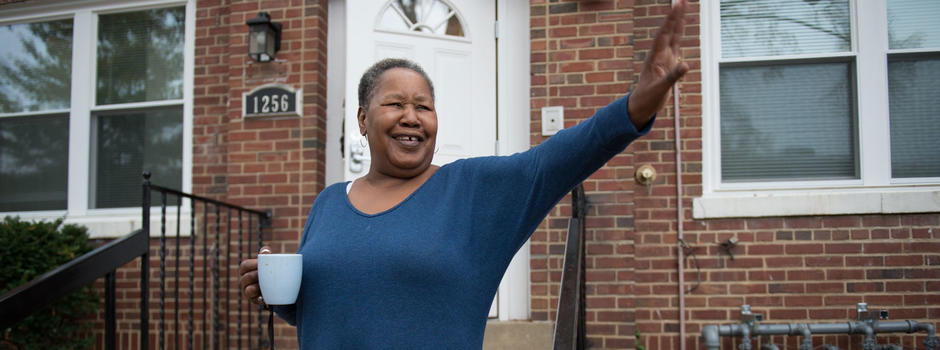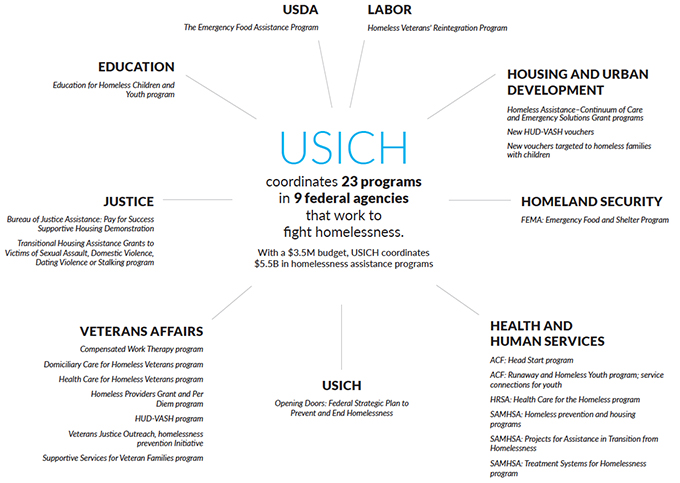
On any given night, nearly 550,000 people—parents, kids, veterans—are homeless.
These numbers, though staggering, represent a drop from 2010, when the US Interagency Council on Homelessness (USICH) released Opening Doors, a federal strategic plan to prevent and end homelessness by the end of 2020.
Ending homelessness doesn’t mean that no one is ever homeless again. It means that homelessness is rare and short because communities have systems to immediately re-house someone who becomes homeless.
Progress has been mixed—some communities have ended veteran homelessness, while others still struggle—but it’s clear that ending homelessness is only achievable if resources are committed to evidence-based programs.
Unlike some social problems with no apparent answers, homelessness is a solvable problem. The solutions are clear and are supported by evidence.
But homelessness is complicated. No federal agency focuses exclusively on homelessness. The work is spread across 19 agencies, many of which have funds that flow down to the local level. These agencies spend about $5 billion a year on targeted efforts to end homelessness. Yet without careful coordination, this funding can be fragmented and ineffective.
That's where USICH and Opening Doors come in. USICH is an autonomous agency established in 1987 to coordinate the federal response to homelessness and work with local governments and the private sector. Though it has taken different forms, USICH has been reauthorized under both Democratic and Republican administrations. Currently, with a staff of about 20 people and a budget of just $3.5 million, USICH coordinates work across several agencies, such as the Departments of Housing and Urban Development (HUD), Health and Human Services, Labor, and Veterans Affairs (VA), and—through regional coordinators around the country—is a liaison between the federal government and people doing work on the ground. The Urban Institute recently conducted interviews with federal and local stakeholders who described the critical role of USICH in efforts to end and prevent homelessness.
Federal Coordination of Targeted Homelessness Assistance Programs
Opening Doors was the first comprehensive federal strategy to end homelessness. To build the plan, USICH sought input from thousands of stakeholders, including agency heads, local nonprofits, mayors, and people who had experienced homelessness. Opening Doors provides targeted strategies that have proven effective and can be implemented by communities across the country, given the proper resources.
Now, seven years after the release of Opening Doors, the work is focused on implementing and measuring the strategies it outlines. By examining which strategies work for different populations, we can understand where more progress is needed and what the field’s next steps could be if Congress reauthorizes USICH instead of eliminating the agency altogether.
Veterans
Goal: Prevent and end homelessness among veterans by the end of 2015
Progress: According to HUD data, between 2010 and 2016, veteran homelessness decreased 47 percent, from 74,087 to 39,471 veterans
Strategies that work: Garner public commitments, orient systems to Housing First, and deploy resources effectively
- In 2014, the Obama administration and USICH launched the Mayors Challenge to End Veteran Homelessness to build public commitment and investment in ending homelessness. Since 2014, 880 mayors and other local officials have committed to the Mayors Challenge, and 36 communities and 3 states have met the federal criteria for ending veteran homelessness.
- HUD and the VA, with USICH’s support, worked to increase the use of the HUD and Veterans Affairs Supportive Housing (HUD-VASH) program and the Supportive Services for Veteran Families (SSVF) program by encouraging communities to commit to a Housing First system orientation. A Housing First orientation reduces time to housing placement and increases housing retention. USICH and other partners worked on the ground to help communities adopt Housing First.
- HUD, the VA, and the Department of Labor launched the Veterans Homelessness Prevention Demonstration to serve veterans experiencing or at risk of homelessness by offering short-term financial assistance, case management, and employment services. In the demonstration's three years, housing stability, employment, and income increased among veterans who had been either homeless or at risk of homelessness.
Chronically Homeless Single Adults
Goal: End chronic homelessness by the end of 2017
Progress: According to HUD data, between 2010 and 2016, chronic homelessness decreased 27 percent, from 106,062 to 77,486 people
Strategies that work: Identify people experiencing long-term homelessness who frequently use other costly systems and provide them supportive housing
- People who experience chronic, or long-term, homelessness often have disabilities and other complex needs and cycle in and out of institutions such as jails and hospitals. Supportive housing helps people stay in housing and improves their well-being and lowers public costs.
- A supportive housing program in Denver, Colorado, targets people who cycle in and out of jail. These people are often cited for minor offenses, such as panhandling or public intoxication. They end up spending a brief period in jail and are released back to the streets, where the cycle perpetuates. Denver hopes to break that cycle by moving people into supportive housing, where they will have a home and services to help stabilize their lives. The project evaluators at Urban have found that the relatively new program is reaching the right people and could save Denver money by reducing arrests and jail stays. Over 90 days, an average individual targeted for the supportive housing program had 24 contacts with the police before their referral to the program, costing the city almost $4,000.
- A project in New York City targeted a similar population experiencing chronic homelessness and frequent criminal justice involvement. Participants in this supportive housing program experienced an increase in housing stability and a decrease in days spent in jail compared with similar people without supportive housing.
Families
Goal: Prevent and end homelessness for families with children by the end of 2020
Progress: According to HUD data, between 2010 and 2016, homelessness among families with children decreased 20 percent, from 241,937 to 194,716 people in families
Strategies that work: Link families to vouchers and rapid re-housing to end homelessness
- In 2010, HUD launched the Family Options Study to understand how to best serve homeless families. The results help us understand what does and does not work, and how much each strategy costs:
- Compared with the services typically offered to homeless families, long-term vouchers to help families pay rent were more effective and only modestly more expensive. More than any other intervention, vouchers helped families find stable long-term housing and improve their lives in other ways. Families who used vouchers to pay rent were less likely to experience economic stress, struggle with food insecurity, or have their children removed.
- Rapid re-housing, a crisis intervention that helps families exit shelter by offering one-time or short-term rental assistance, helped families exit homelessness and avoid more costly transitional housing programs, but did not lead to long-term housing stability for all families.
- Transitional housing was more costly and not effective. Transitional housing provides families temporary housing and intensive services focused on increasing well-being and self-sufficiency. In this study, however, families who received transitional housing were only slightly less likely to return to shelters than families who did not receive priority access to any particular program. The program did not meet its goals of helping families become self-sufficient and demonstrated no differences in child and family well-being.
Unaccompanied Youth
Goal: Prevent and end homelessness for youth by the end of 2020
Progress: According to HUD data, on a single night in January 2016, there were approximately 35,686 unaccompanied homeless youth. This number is widely viewed as an undercount.
Strategies that work: Strengthen data collection to understand youth homelessness and build community capacity for a unified, collaborative response
- There are no reliable data to understand how many youth experience homelessness. The first challenge in ending youth homelessness has been accurately counting unaccompanied homeless youth. Without an accurate count, it is hard to expand housing and services or to track progress. In 2013, nine communities participated in the Youth Count! Initiative, run by USICH, HUD, and the Departments of Health and Human Services and Education. From this initiative, Urban identified promising practices that can inform communities working to end youth homelessness.
- Voices of Youth Count, a project of Chapin Hall at the University of Chicago, has brought 22 communities together with youth, researchers, and implementation partners to better understand youth homelessness. Voices of Youth Count conducts counts, interviews, and surveys with homeless youth and reviews evidence and data to provide tools for ending youth homelessness.
- In January 2017, HUD announced a $33 million award to 10 communities as part of the Youth Homelessness Demonstration Project. The demonstration, created with input from youth who have experienced homelessness, asks the 10 selected communities to develop a comprehensive system of care for homeless youth.
The progress communities have made toward ending homelessness demonstrates that this goal can be achieved, but more work remains. Opening Doors provides clear strategies to move forward, but carrying out those strategies will require sustained commitment from local communities and the federal government. HUD secretary Ben Carson has said he plans to build on USICH’s progress, but questions abound as to whether USICH, HUD, and other agencies that work to end homelessness will have the money to continue their progress. It’s critical that they do. Homelessness can only be solved through continued investment in strategies that work for veterans, the chronically homeless, and children and families.
Project Credits
RESEARCH Sarah Gillespie, Mary Cunningham
DATA VISUALIZATION: Vivian Hou
DESIGN Christina Baird
EDITING: David Hinson
Photo credit: Janet Sharpe waves to a passing neighbor outside of her new home in Washington, DC on Nov. 2, 2015. Photo by Kate Patterson for the Washington Post via Getty Images.
